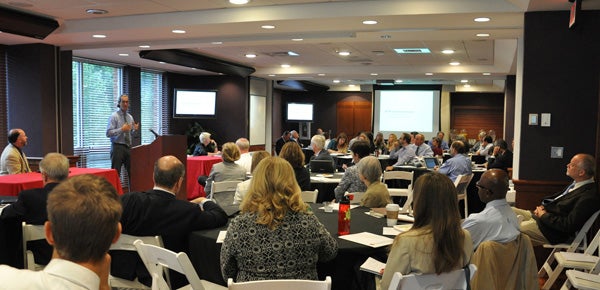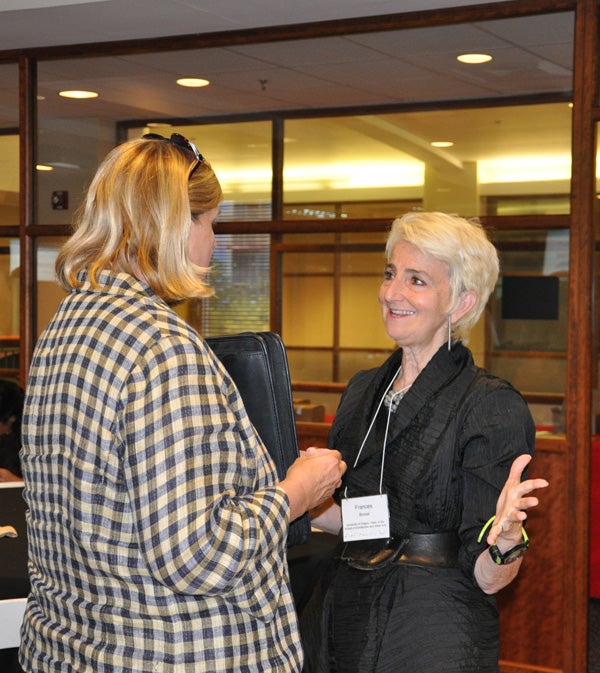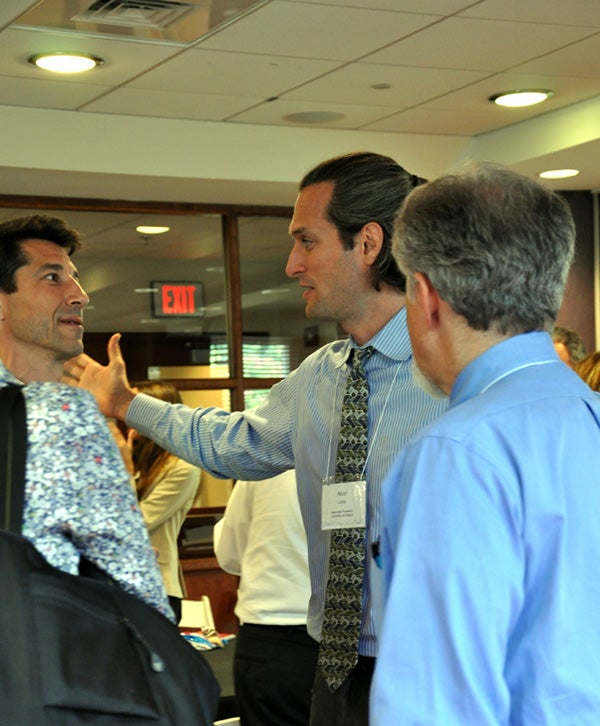Dean Frances Bronet and Associate Professor Nico Larco led a panel discussion in September at the University of Maryland, which is exploring the possibility of establishing an institute similar to UO’s Sustainable City Year Program (SCYP).
Bronet and Larco, along with City of Springfield Assistant City Manager Jeff Towery, led the hour-long “Panel: Oregon Model” at the daylong workshop in College Park, Maryland, in late September.
“The Oregon model plays well,” says Professor Gerrit Knaap of the Urban Studies and Planning Department at the University of Maryland. “I’m hoping it will inspire the Maryland folks to agree that we need something like it in Maryland.” Knaap is director of the National Center for Smart Growth (NCSG), founded in 2000 to conduct research and leadership training on smart growth and related land use issues in Maryland, in metropolitan regions around the nation, and in Asia and Europe.

Above: Associate Professor Nico Larco leads a panel discussion before a full house at the University of Maryland in September. Larco and A&AA Dean Frances Bronet, along with City of Springfield Assistant City Manager Jeff Towery, (seated at table far left), were invited to present SCYP concepts to administrators and other officials hoping to start a similar concept in Maryland.
It’s not the first time that Larco, codirector of the Sustainable Cities Initiative (SCI), or his fellow codirector, Associate Professor Marc Schlossberg, have reached out to share the successes of the SCI and SCYP. In 2012 and 2013, the two led replication conferences where they shared how UO organized the SCYP, helping other institutions use the UO experiences to springboard their own sustainability initiatives.
The University of Minnesota and the University of Iowa, both of which have created sustainability partnership programs based on Oregon’s SCYP-model, were also invited to present at the conference, a clear indication that UO’s SCYP has spurred a burgeoning national movement.
Of the Maryland workshop, Larco says, “In short, they are trying to see how the Oregon model of SCYP could work for them. We are getting more and more requests of this kind throughout the country and internationally.”
Knaap began “a conversation” eighteen months ago with the Maryland Department of Natural Resources and the Office of the Governor “about creating an ‘Institute for Sustainable Maryland,’ ” Knaap says. “In doing background research, we discovered your SCY program and were intrigued.” To learn more, a staff member from the Maryland governor’s office attended the [SCYP replication] conferences in Portland and Eugene. “We liked what we saw,” Knaap says.
The primary purpose of the Maryland workshop, he says, was “to build a constituency” in Maryland for an idea like the SCYP. “We don't believe we can get local governments to pay the sums Salem, Springfield, and Medford paid the SCY program. We hope our funding sources will include funding from the university, the state government, foundations, businesses, and local governments. To make that happen we need to have these constituencies on board. And that is the purpose of the workshop.”
Larco and Towery encouraged local governments to creatively approach the funding needed for SCY participation rather than assuming the bar was set too high.
“There’s potential sticker shock associated with the costs of the program,” Towery acknowledged. “What I told them was we didn’t approach it as if we were going to come up with one gross amount of money close to $200,000. We instead looked at it from the perspective of having sixteen projects we’re interested in doing, then seeking out smaller chunks of $10,000 or $15,000 from different sources, like stormwater assessments. When each project has its own funding stream it’s not as big a deal; [the City of Springfield does] that all the time. And as partners in a HUD grant, we realized that a number of our SCY projects would be eligible for reimbursement.“
Knaap hopes that having had Bronet, Larco, and Towery present at the conference will aid “the transfer of information and enthusiasm” needed to compel funding. Larco’s presentation, Knaap says, appealed to “students, faculty, and administrators, focusing primarily on the benefits of an active learning program to the university community,” he says. Bronet focused “on how the SCY program has benefited the university at large both within and outside Oregon.” Towery, Knaap says, “conveyed how he was once skeptical that the program would have value to local government but how the experience far exceeded expectations.”

Above: A&AA Dean Frances Bronet talks with a workshop attendee about options for beginning a program like Oregon’s SCYP.

Above: Larco answers questions after the presentation.
